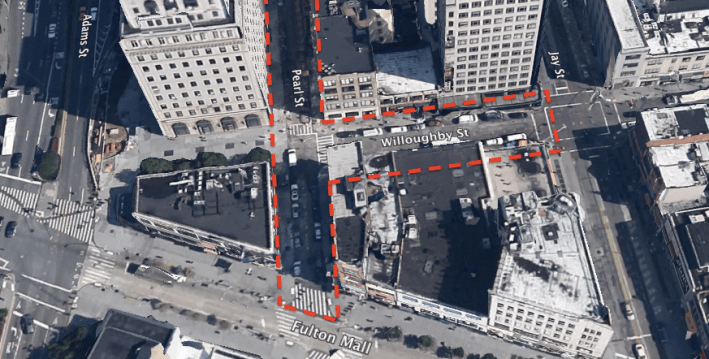
Three narrow blocks near Willoughby Plaza in Downtown Brooklyn could become "shared space" streets under a DOT plan to blur the lines between sidewalks and car lanes. The concept has been under discussion for years as a way to slow motorists and give pedestrians more breathing room, and the city is now studying this concept in earnest. There are some funds allocated for construction, and DOT is planning to get feedback on potential designs at a public meeting next month.
“This is a different type of space," said Laurel Brown of the Downtown Brooklyn Partnership. "It’s not exactly a plaza where you don’t expect to see cars. It’s not exactly a street where you don’t expect to see people.”
The project would build on the success of Willoughby Plaza, which reclaimed an adjacent block from cars in 2006 and became the city's first pedestrian plaza project to be cast in concrete early last year. Two of the proposed shared space blocks are on Pearl Street, running north of Fulton Mall until the street dead-ends at the Brooklyn Renaissance Plaza office tower. The other block is on Willoughby Street between Pearl and Jay Streets, immediately east of the plaza. In addition to people walking between Jay Street and Borough Hall, the streets are used primarily for loading and drop-offs, not through traffic. They are also full of parked cars, many using placards.
“We’re looking at some potential designs that will recognize the unique uses there, as opposed to putting down a typical New York City street," said Chris Hrones, DOT's Downtown Brooklyn Transportation Coordinator, at a meeting of Community Board 2's transportation committee last night. “We’re exploring some unconventional design approaches."
Shared streets are not unprecedented in New York. South Street Seaport has some shared space, and Hrones pointed to a block of 165th Street between Jamaica and 89th Avenues, beside the Jamaica Colosseum Mall in Queens, as another example. While dense neighborhoods like the Financial District and Downtown Brooklyn are ripe for shared space, the city typically hasn't identified it as an option.
Because the project would likely remove curbs and include other structural changes, DOT is planning for permanent construction right off the bat instead of starting off with temporary materials. Construction is partially funded with $780,000 in the capital budget, but more would be needed before ground is broken. (For comparison, one-block Willoughby Plaza cost $2 million.) The study currently underway costs $350,000, DOT said.
“This is something that’s been talked about for a couple years now, and it was just a matter of getting everybody to the table," said the Downtown Brooklyn Partnership's Brown. DOT has reached out to New York University, which is moving into 370 Jay Street, nearby property owner Muss Development, Brooklyn Friends School, and the MTA, in addition to Community Board 2 and the Downtown Brooklyn Partnership, which Hrones said is reaching out to smaller property owners and business owners.
The area already has a very low crash rate because drivers are not going very fast, Hrones said. The agency will likely schedule a public forum in late October to gather feedback on conceptual designs.





